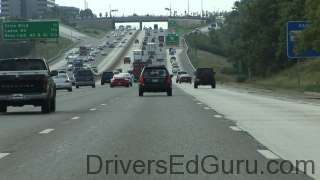Stage 4: Getting Acquainted with the Freeway
Locations: Divided highways
Length of lessons: 25-35 minutes
Many new drivers are afraid to drive on divided highways. Typically, the speeds are 50% faster than they’re used to (60-65mph versus 40mph on most city roads), there are more lanes of traffic, there are large trucks, and there’s the whole merging thing to deal with. However, divided highways are actually quite safe.

Divided Highways are Quite Safe
As we’ve pointed out in other areas of this site, intersections are the most dangerous areas on the road. That’s because you’ve got impatient drivers criss-crossing each other at relatively high speeds. Even if you’re only traveling at 35mph, if you hit someone head-on who is also traveling 35mph, it’s the equivalent of hitting a brick wall at 70mph.
Divided highways, fortunately, have a number of safety advantages over other roads:
- Divided highways do not have cross traffic or intersections.
- Because traffic is divided, the likelihood of a head-on crash is decreased.
- There are fewer fixed objects on the side of the road. Many new drivers collide with trees, telephone poles, and other fixed objects along the side of the road.
- Wide shoulders provide an emergency escape route.
Increase your forward search
Stress to your teen that the higher speeds on the freeway require lengthening their forward search. It also means narrowing their peripheral search to only their lanes. City and residential streets require a wider search as you must be aware of bicyclists, pedestrians, and cars on the side of the road. On the highway, however, you need to focus on the area immediately surrounding your car as well as the cars up to a quarter mile down the road.
Increase your following distance
Whenever you increase your speed, you should increase your following distance. You must point out to your teen that most drivers on the highway don’t maintain an appropriate three to four second following distance. Often times, cars on the highway drive dangerously close to each other. Stress to your teen that when traveling at high speeds, they need a minimum cushion of three seconds in order to react to changing conditions. They shouldn’t feel intimidated by tail-gaters to close the gap between themselves and the car ahead of them.

Watch for Brake Lights
Highway traffic can decelerate from 65mph to 15mph in a very short time period. To avoid being caught off-guard by these quick speed changes, teach your teen to look for the brake lights of cars in the distance. By looking far down the highway (up to a quarter mile), they can get a heads up on speed changes.
As soon as your teen sees brakes lights coming on up ahead, they should immediately cover the brake. This will give them a little extra cushion in case they need to apply brake pressure.
If your teen has noticed they have a tailgater, I also recommend applying slight brake pressure to encourage that driver to back off a bit. This may help your teen avoid a dangerous rear-end collision in the case of a quick slow-down.
Check out the tip from professional driver, Johnny Parsons, regarding watching brake lights.
Start your lessons during non-peak hours
When first tackling the highway, confine your practice to off-peak daylight hours on Saturday or Sunday. Of course, before you head out there, your teen is going to be worried about actually getting on to the highway.
Continue on to Highway Merging

